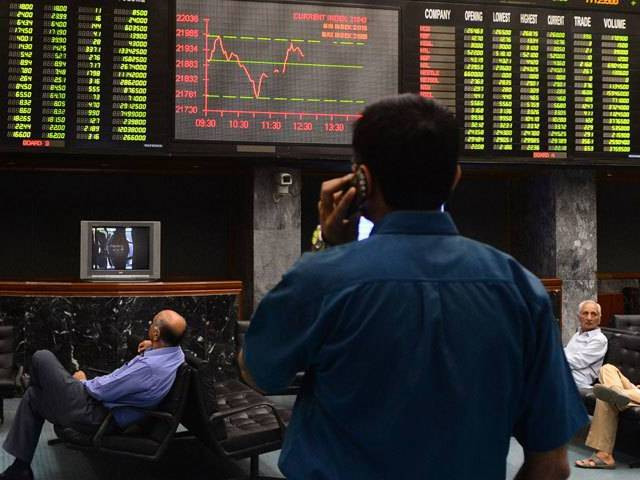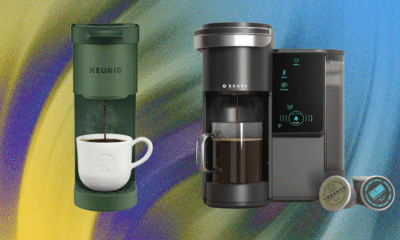Business
From PepsiCo to Taco Bell, dirty soda is taking over

Utah-based drink chain Swig coined “dirty soda” back in 2010. Fifteen years later, the trend is fueling innovation everywhere from PepsiCo to McDonald’s, infusing the sluggish beverage category with new life.
“Dirty soda” drinks use pop as a base, followed by flavored syrups, cream or other ingredients. While Swig claims credit — and the trademark — for dirty soda, TikTok videos and the reality TV show “The Secret Lives of Mormon Wives” have helped the trend spread far and wide, outpacing even the soda chain’s speedy expansion.
Now, consumers can find it nearly everywhere, from grocery store aisles to fast-food chains.
In a few weeks, Pepsi plans to unveil two ready-to-drink dirty soda-inspired beverages at the National Association of Convenience Stores trade show in Chicago. The new drinks, the Dirty Dew and the Mug Floats Vanilla Howler, follow on the heels of the Pepsi Wild Cherry & Cream flavor, which hit shelves earlier this year.
“I think it’s a great opportunity for people like us, like PepsiCo, and for consumers to experience soda in a new way — and in some ways, an old way,” Pepsi Beverages North America Chief Marketing Officer Mark Kirkham told CNBC, comparing the rise of dirty soda to root beer floats and the soda shops of yore.
PepsiCo’s lineup of dirty soda-inspired drinks includes Pepsi Wild Cherry & Cream, Dirty Mountain Dew and Mug Floats Vanilla Howler.
Source: PepsiCo
Dirty soda has also drawn new interest beyond beverage players. According to Datassential, 2.7% of U.S. eateries offer a carbonated soft drink that includes cream or milk, up from 1.5% a decade ago.
Newcomers to the trend include TGI Fridays, which launched dirty soda as a limited-time menu item this summer that could be spiked with alcohol. McDonald’s is testing flavored sodas, like a “Sprite Lunar Splash,” at more than 500 locations after winding down its drinks-focused spinoff CosMc’s in June. Yum Brands’ Taco Bell has also been offering limited-time menu items, like a dirty Mountain Dew Baja Blast.
Swig sets a trend
These days, Swig has grown to more than 140 locations across 16 states. So far this year, its same-store sales have risen 8.2%, according to the privately held company. The Larry H. Miller Company, an investment firm founded by the former Utah Jazz owner, bought a majority stake in Swig in 2022 for an undisclosed sum.
“I think we’re doing for soda what Starbucks did for coffee,” Swig CEO Alex Dunn said.
As Swig has grown, so have the number of chains looking to emulate its success. Rival soda shops like Sodalicious, Fiiz and Cool Sips are also benefiting from the trend. Coffee shops, like Dutch Bros., have also added it to their menus. And now fast-food chains are hopping on the bandwagon.
“It validates that this is a category, and McDonald’s and Taco Bell wouldn’t be getting into it if it wasn’t something that had broad appeal that they could sell everywhere, in thousands of locations,” Dunn said. “It’s kind of flattering that we created a category that now everybody is copying.”
For restaurants, adding dirty soda to the menu is easier than it might sound.
“It’s a custom drink offering that, one, allows the brands to leverage something that they already have right there: their soda machine,” said Erica Holland-Toll, culinary director at The Culinary Edge, which advises restaurants on food and beverage innovation. “Two, it incorporates either a one-touch ingredient, or if they’re already open for breakfast, it’s quite likely that they’ve got a creamer in house.”
On the other hand, offering customizable coffee drinks is usually much more difficult — which has contributed to the struggles at Starbucks.
“The espresso world — that’s so much more complicated,” Holland-Toll said.
Dirty soda also has wide appeal. With less caffeine than coffee, consumers can drink it all day long. Plus, it’s “much more accessible” than some coffee house trends, like an espresso tonic, according to Holland-Toll. The bright colors of many dirty sodas also make them more attractive to consumers, who were likely introduced to the trend via a TikTok video.
But perhaps above all, dirty soda can help restaurants draw in customers who are otherwise feeling thrifty.
“It’s an affordable fun treat. You’re not going out and spending $30 or $50, right?” said Sally Lyons Watt, chief advisor of consumer goods and foodservice insights for Circana. “It’s something that people can walk away saying, ‘Wow, that was yummy’ or ‘I feel better because I just had that.'”
A pop for beverage companies
Swig drinks.
Courtesy: Swig
A “fun treat” for consumers is adding up for beverage companies, helping reverse the decades-long trend of declining soda consumption in the U.S.
As health concerns mount and the array of beverage options expands, Americans have been drinking less soda for roughly two decades. In 2004, soda consumption peaked at 15.3 billion gallons, according to Beverage Marketing; by 2024, that figure had slid to 11.87 billion gallons. But consumption of carbonated soft drinks has been ticking up in the last two years, with 2025 estimated to reach 11.88 billion gallons. The rise of dirty soda, plus the growing popularity of prebiotic sodas, has likely helped the segment halt its downward trajectory.
Over the years, iced coffee has been stealing what the beverage industry calls “share of throat” from soda. With dirty soda, consumers can marry their love of customizing a cold drink with the lower caffeine content and taste of soda.
“The carbonation makes it feel lighter in your mouth than coffee, for example,” Holland-Toll said.
Dirty soda has also been attracting younger consumers who previously didn’t drink much Pepsi or Dr Pepper. Swig’s core customer base is young women between the ages of 18 and 35, according to Dunn.
That’s true for Holly Galvin, a 31-year-old human resources professional based in Davenport, Iowa. She told CNBC that she rarely drank soda — until she saw dirty soda take the spotlight in the “The Secret Lives of Mormon Wives” last year. Now she makes her own dirty soda once or twice a week at home. With the onset of autumn, her go-to recipe these days uses Diet Dr Pepper as a base, with pumpkin spice creamer and a sprinkle of pumpkin pie spice on top.
Broadly, younger consumers are more inclined to seek out new drinks compared with older cohorts. Nearly three-quarters of Generation Z try a new beverage every month on average, according to Keurig Dr Pepper’s 2025 trend report.
Beverage companies say that they are seeing a broader halo effect for soda as a result of the trend.
“For us, it serves as a recruitment tool, bringing new users into the trademark,” said Katie Webb, vice president of innovation and transformation for Keurig Dr Pepper. “It really draws them all the way back to the base brand, which ends up being extremely impact for us long after.”
And just as craft cocktail culture led to the rise of canned cocktails, the popularity of dirty soda is leading beverage giants to cash in with ready-to-drink versions that capitalize on the trend. Dr Pepper Creamy Coconut was the company’s most successful limited-time carbonated soft drink to date, based on retail dollar sales, according to Webb. And Kirkham said Pepsi Wild Cherry & Cream has been one of the fastest-growing flavor segments for the company.
“Some trends start retail and move over to foodservice,” Circana’s Lyons Wyatt said. “This one was a foodservice trend moving into retail.”
With Pepsi Wild Cherry & Cream and next year’s launch of Dirty Dew and the Mug Floats Vanilla Howler, Kirkham expects that consumers will become even more creative with their concoctions.
“I think it’s actually giving [consumers] the chance to experiment even more and customize more,” he said. “Now you have a brand new base.”
Business
US agrees deal to slash Swiss tariffs to 15% after golden charm offensive

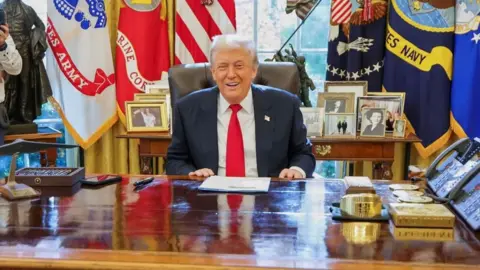 AP
APPaul KirbyEurope digital editor
Switzerland and the US have agreed to cut President Donald Trump’s steep 39% tariffs on Swiss exports to 15%, as part of a deal that involves a Swiss promise to invest $200bn (£150bn) in the US.
“It’s a great relief for our economy,” said Swiss Economics Minister Guy Parmelin, who said significant damage had been done since the additional tariffs had kicked in last August.
Parmelin said a move by Swiss business leaders to meet Trump in the White House last week had proved “decisive” in reaching a deal.
Industry chiefs visited the Oval Office, bearing gifts including a Rolex gold watch and a specially engraved gold bar from Swiss-based gold refining company MKS.
Initial attempts by Swiss President Karin Keller Sutter to change Trump’s mind had fallen on deaf ears. Trump said she “was a nice woman, but she did not want to listen”.
But after the 4 November encounter with Swiss business leaders, Trump revealed this week a deal was being worked on.
US Trade Representative Jamieson Greer confirmed an agreement had been reached, saying “President Trump’s unmatched dealmaking continues to deliver for the American people”.
The deal had involved very hard work, said chief trade negotiator Helene Budliger Artieda. Guy Parmelin said it would bring Switzerland into line with the 15% tariff rate negotiated with the US by its European Union neighbours.
The economics minister said it involved the Swiss economy investing $200bn directly in the US by 2028. A third of that Swiss money will be invested in the US in 2026 under the deal.
Switzerland has also agreed to axe tariffs on a quota of US meat exports including beef, bison and poultry.
Greer said the deal “tears down longstanding trade barriers” and Swiss investment would bring thousands of new jobs.
For Swiss industry, the deal could not come soon enough. Tech exports to the US are down 14.2% on the third quarter of last year, according to latest statistics – a dramatic fall since the tariff hike was imposed in August.
The role of Swiss industrialists appears to have been key, and some particularly those trading in luxury goods, gold, or commodities, already had contacts in Trump’s circle.
In September, Trump appeared at the US Open tennis final in the Rolex VIP box hosted by the Swiss watch company’s chief executive Jean Frédéric Dufour.
 MANDEL NGAN/AFP
MANDEL NGAN/AFPThe president even asked if the Rolex CEO would have been there if Trump had not slapped such steep tariffs on Switzerland.
Last week Dufour met Trump again, this time in the Oval Office, along with fellow business leaders including Johann Rupert from luxury goods maker Richemont and Marwan Shakarchi from MKS.
Days after the meeting, Trump was pictured in the Oval Office with what looked very much like a Rolex “Datejust” desk clock, produced by the company as a collector’s item, and worth tens of thousands of dollars.
A White House official has confirmed to the BBC the two items were given to Trump.
It is quite normal nowadays for visitors to the Oval Office to come bearing a gift.
UK Prime Minister Sir Keir Starmer brought an invitation from King Charles for a lavish state visit. German Chancellor Friedrich Merz offered a framed copy of the birth certificate of Trump’s German grandfather.
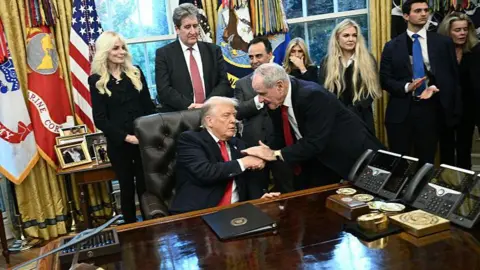 BRENDAN SMIALOWSKI/AFP
BRENDAN SMIALOWSKI/AFPThe US president receives thousands of gifts every year and they then become US property, deposited with the National Archives and filed annually by the state department.
They are eventually transferred to a presidential library. Some gifts can be kept but presidents have to pay federal taxes if they do not come from a close relative.
Swiss industry has been waiting for a deal with bated breath and a number of Swiss companies had warned they would have to furlough staff if nothing changed.
Yves Bugmann, who heads the Swiss Watch Industry Federation, welcomed the deal after months of uncertainty.
Asked what kind of investment the Swiss government might make in the US that would add up to $200bn, Helene Budliger Artieda said there was a detailed list that included pharmaceuticals, but she singled out plans for plane manufacturer Pilatus to build a big US plant and train-maker Stadler to expand its US operations in Utah.
Gold refining is also part of the plan.
“Currently, Switzerland is the primary location for gold storage, and New York is the primary location for trading,” said trade negotiator.
The chief trade negotiator said it would take a few days or even weeks for the changes to come into effect.
The agreement will only become binding when it receives approval from the Swiss parliament, and then it will be put to a referendum.
Business
Trade push: India seeks faster Russian clearances as both sides target $100 bn by 2030; pharma and marine approvals on priority – The Times of India

India has asked Russia to fast-track approvals for Indian exporters –including expedited listing of domestic establishments and quicker registration of marine and pharmaceutical products — as part of a broader push to expand two-way trade, the commerce ministry said on Thursday.Commerce secretary Rajesh Agrawal, currently in Moscow, stressed the need for “confidence-building measures to unlock market access” during discussions with Russian officials at the 26th Meeting of the India-Russia Working Group on Trade and Economic Cooperation, reported ET.“The issues included expedited listing of Indian establishments and a systems-based approach with FSVPS in agriculture, especially marine products and a time-bound pathway in pharmaceuticals covering registration, regulatory reliance and predictable timelines,” the official statement said, quoted ET. FSVPS is Russia’s Federal Service for Veterinary and Phytosanitary Supervision.Agrawal and Russian deputy minister of economic development Vladimir Ilyichev finalised and signed a forward-looking protocol covering multiple sectors aimed at strengthening economic ties. Bilateral trade currently stands at $25 billion, with both sides committed to raising it to $100 billion by 2030.The working group identified opportunities across engineering goods, chemicals and plastics, electronics, pharmaceuticals, agriculture, leather and textiles. It also mapped areas where Indian strengths –including smartphones, motor vehicles, gems and jewellery, organic chemicals, textiles and leather — can support Russia’s trade diversification and de-risking strategy.In services, India encouraged Russian entities to increase procurement of Indian IT-BPM, healthcare, education and creative services. It also pushed for predictable mobility for Indian professionals amid growing labour shortages in Russia.India highlighted its global capability centre (GCC) ecosystem — over 1,700 centres employing nearly 1.9 million professionals — as a ready platform for Russian firms to enhance business continuity, cybersecurity, design, analytics and shared-services support, bolstering supply-chain resilience.The Indian side acknowledged Russia’s interest in concluding a bilateral investment treaty. Both countries also agreed to “explore payments solutions to meet the needs for businesses, especially medium, small and micro enterprises,” the ministry said.The engagement comes ahead of intensified bilateral activity, with Russian President Vladimir Putin scheduled to visit India on December 5 for the Russia-India Forum.
Business
Jaguar Land Rover cyber attack cost company nearly £200m

A cyber attack on Jaguar Land Rover (JLR) cost it nearly £200m, the company has announced.
The UK’s largest car manufacturer said it has “made strong progress” in recovering its operations at pace since the attack.
JLR stopped production across its UK factories for five weeks from 1 September after being targeted by hackers a day earlier.
All of the group’s manufacturing sites – including factories in Solihull, West Midlands, and Halewood, Merseyside – restarted operations last month.
JLR has revealed it swung to an underlying loss of £485m over the second quarter of the year as earnings were knocked following a severe cyber attack.
The British luxury carmaker had made a profit before tax and exceptional items of nearly £400m over the same period in 2024.
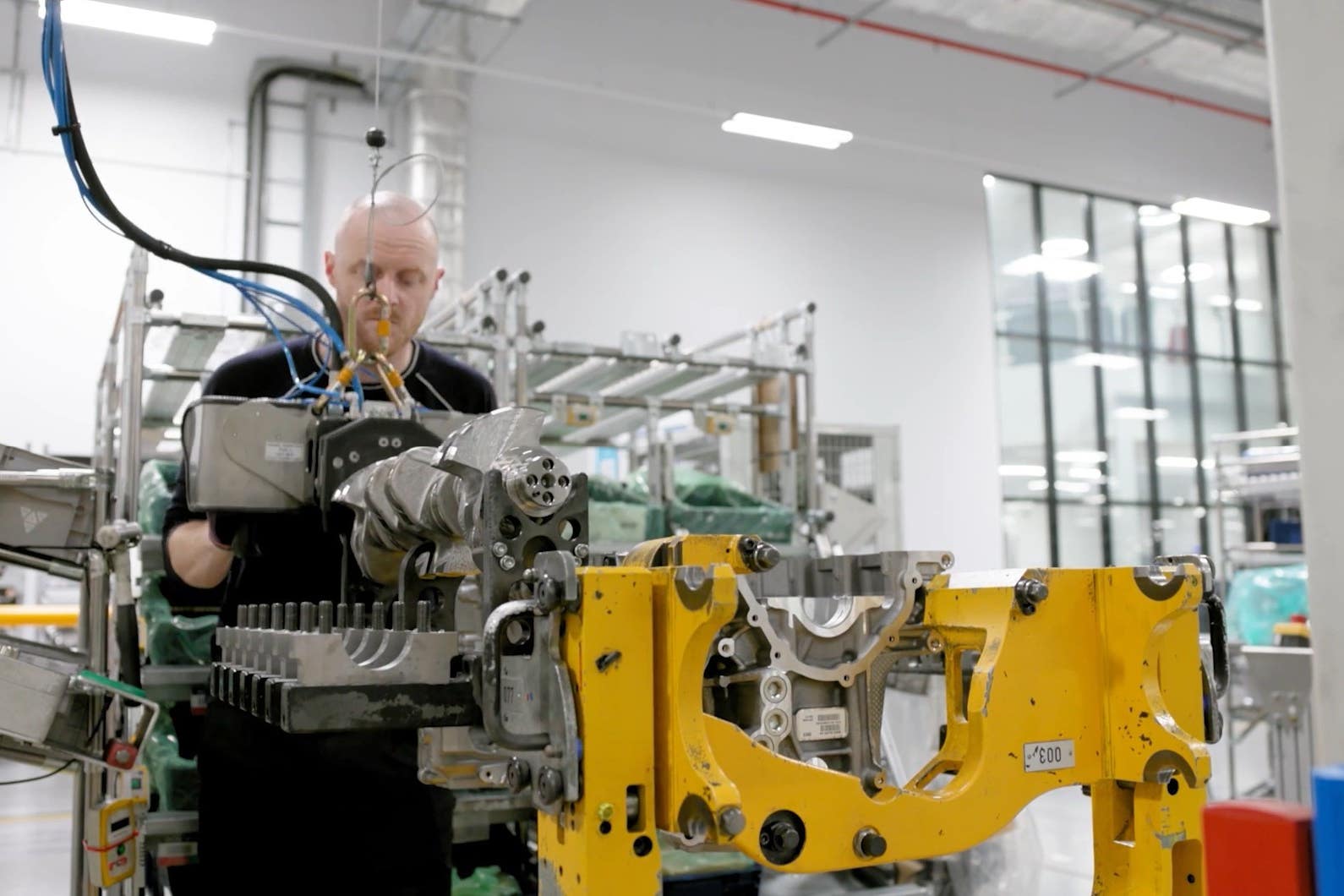
It also reported a £134m loss for the six months to the end of September, from a £1.1bn profit the prior year.
JLR’s chief executive Adrian Mardell said the company’s financial performance was “impacted by significant challenges, including a cyber incident that stopped our vehicle production in September and the impact of US tariffs”.
The manufacturer revealed costs of £196m relating to the cyber attack.
The cyber attack on Jaguar Land Rover is thought to have been the UK’s most economically damaging hack and is estimated to have cost the country £1.9bn.
Research from the Cyber Monitoring Centre indicates that around 5,000 businesses nationwide have been hit by the fallout.
Its experts analysed the incident’s broad impact across the economy and supply chain to arrive at the figure.
Jaguar Land Rover halted production at its UK factories for five weeks from 1 September after being targeted the previous day.
This disruption led to warnings from suppliers that many faced collapse without rapid trading resumption or financial aid.
-

 Entertainment6 days ago
Entertainment6 days agoChina unveils£5.4 bn Fujian, its most advanced aircraft carrier yet
-
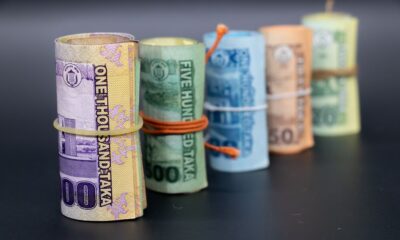
 Fashion1 week ago
Fashion1 week agoBangladesh Bank allows foreign currency-taka swap facility for dealers
-

 Tech1 week ago
Tech1 week agoThe AI Data Center Boom Is Warping the US Economy
-

 Politics6 days ago
Politics6 days agoIDF lawyers warned of possible Gaza war crimes: US intel findings
-
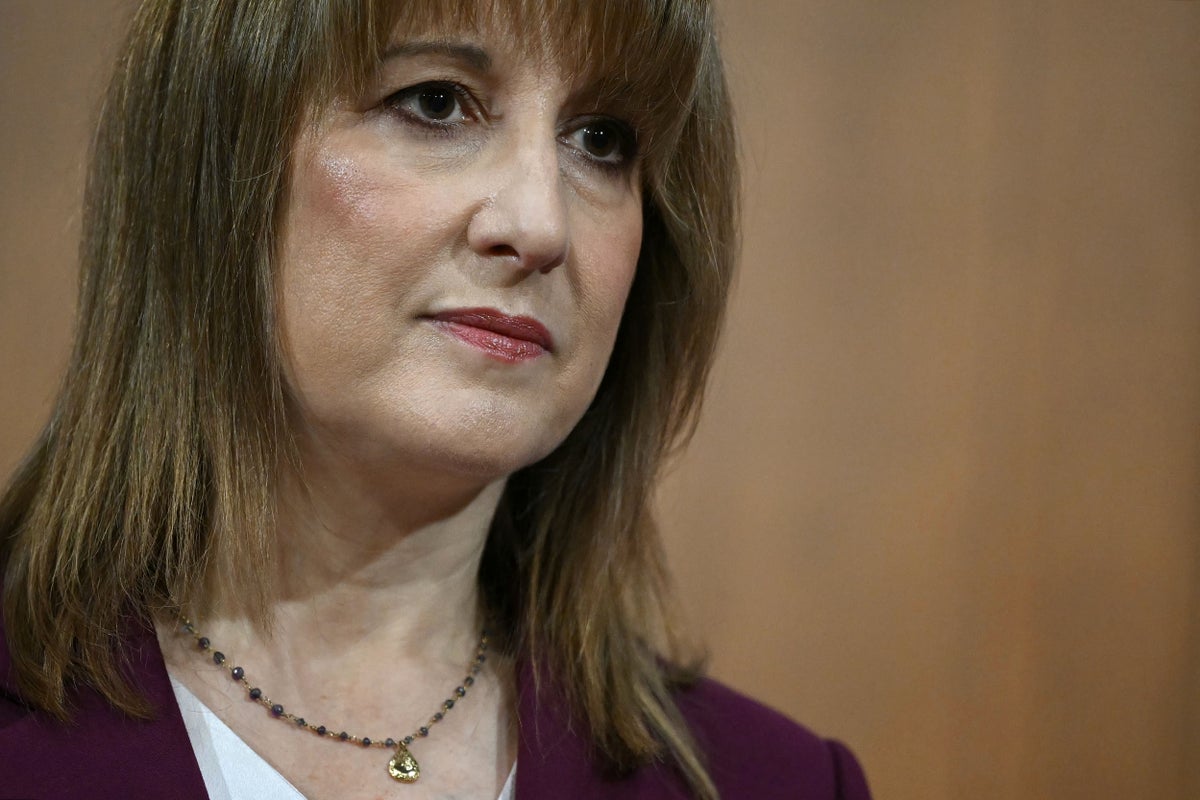
 Business1 week ago
Business1 week agoBudget tax hikes could see food prices soar, major supermarket boss warns
-

 Business1 week ago
Business1 week agoFM asks banks to ensure staff speak local language – The Times of India
-

 Entertainment7 days ago
Entertainment7 days agoRobert Pattinson jokes about competing with Gen Z
-

 Tech1 week ago
Tech1 week agoWhy fears of a trillion-dollar AI bubble are growing


